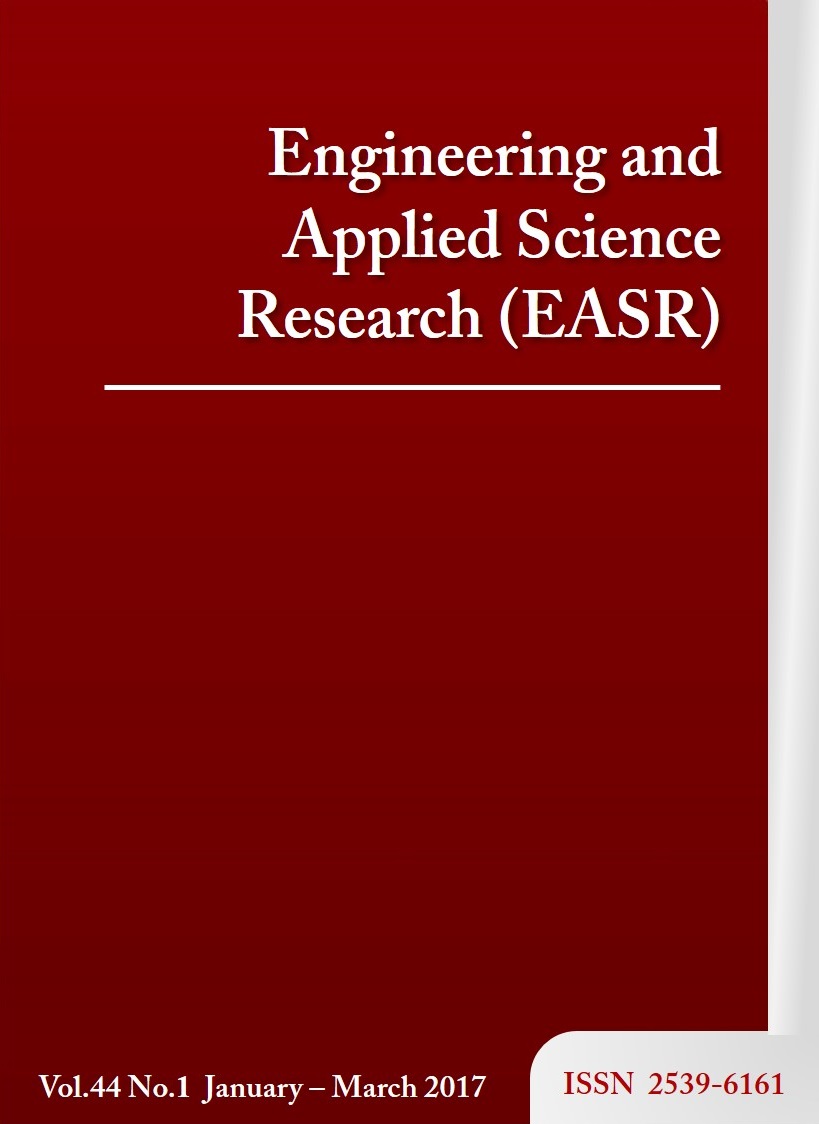Mean atmospheric temperature model estimation for GNSS meteorology using AIRS and AMSU data
Main Article Content
Abstract
In this paper, the problem of modeling the relationship between the mean atmospheric and air surface temperatures is addressed. Particularly, the major goal is to estimate the model parameters at a regional scale in Thailand. To formulate the relationship between the mean atmospheric and air surface temperatures, a triply modulated cosine function was adopted to model the surface temperature as a periodic function. The surface temperature was then converted to mean atmospheric temperature using a linear function. The parameters of the model were estimated using an extended Kalman filter. Traditionally, radiosonde data is used. In this paper, satellite data from an atmospheric infrared sounder, and advanced microwave sounding unit sensors was used because it is open source data and has global coverage with high temporal resolution. The performance of the proposed model was tested against that of a global model via an accuracy assessment of the computed GNSS-derived PWV.
Article Details
This work is licensed under a Creative Commons Attribution-NonCommercial-NoDerivatives 4.0 International License.
References
Brutsaert W. Hydrology: an introduction. New York: Cambridge University Press; 2005.
Awange JL. Environmental monitoring using GNSS: Global navigation satellite systems. New York: Springer-Verlag Berlin Heidelberg; 2012.
Awange J, Fukuda Y. On possible use of GPSLEO satellite for flood forecasting. International civil engineering conference on sustainable development in the 21st century The Civil Engineer in Development; 2003 Aug 12-16; Nairobi, Kenya. p. 12-6.
Wang B, Zhao L, Bai X. The characteristics investigation of ground-based GPS/PWV during the 7.21 extreme rainfall event in beijing. In: Sun J, Liu J, Fan S, Lu X, editors. China Satellite Navigation Conference (CSNC) 2015; 2015 May 13-15; Xian, China. New York: Springer-Verlag Berlin Heidelberg; 2015. p. 563-74.
Bevis M, Businger S, Herring TA, Rocken C, Anthes RA, Ware RH. GPS meteorology: Remote sensing of atmospheric water vapor using the global positioning system. J Geophys Res Atmos. 1992;97(D14): 15787-801.
Baker H, Dodson A, Penna N, Higgins M, Offiler D. Ground-based GPS water vapour estimation: potential for meteorological forecasting. J Atmos Sol Terr Phys. 2001;63(12):1305-14.
Sapucci LF. (2014). Evaluation of modeling watervapor-weighted mean tropospheric temperature for GNSSintegrated water vapor estimates in Brazil. J Appl Meteorol Clim. 2014;53(3):715-30.
Alshawaf F, Fersch B, Hinz S, Kunstmann H, Mayer M, Meyer F. Water vapor mapping by fusing InSAR and GNSS remote sensing data and atmospheric simulations. Hydrol Earth Syst Sci. 2015;19(12): 4747-64.
Wilgan K, Rohm W, Bosy J. Multi-observation meteorological and GNSS data comparison with numerical weather prediction model. Atmos Res. 2015;156:29-42.
Mendes V, Prates G, Santos L, Langley R. An evaluation of the accuracy of models for the atmosphere. Proceedings of the 2000 National Technical Meeting of The Institute of Navigation; 2000 Jan 26-28; Anaheim, California. p. 433-8.
Schueler T, P´osfay A, Hein GW, Biberger R. A global analysis of the mean atmospheric temperature for GPS water vapor estimation. Proceedings of 14th International Technical Meeting of Satellite Division of The Institute of Navigation; 2001 Sep 11-14; Utah, USA. p. 2476-89.
Satirapod C, Anonglekha S, Choi YS, Lee HK. Performance assessment of GPS-sensed precipitable water vapor using igs ultra-rapid orbits: a preliminary study in thailand. Eng J. 2010;15(1):1-8.
Saastamoinen, J. Atmospheric correction for the troposphere and stratosphere in radio ranging satellites. In: Soren WH, Armando M, Bernard HC, editors. The use of artificial satellites for geodesy. Washington, DC: American Geophysical Union; 1972. p. 247-51.
Olsen E, Fetzer E, Hulley G, Manning E, Blaisdell J, Iredell L, et al. AIRS/AMSU/HSB version 6 level 2 product user guide. USA: NASA-JPL Tech Rep; 2013.
Divakarla MG, Barnet CD, Goldberg MD, McMillin L M, Maddy E, Wolf W, et al. Validation of atmospheric infrared sounder temperature and water vapor retrievals with matched radiosonde measurements and forecasts. J Geophys Res Atmos. 2006;111(D9):1-20.
Kleynhans W, Olivier JC, Wessels KJ, van den Bergh F, Salmon BP, Steenkamp KC. Improving land cover class separation using an extended kalman filter on modis ndvi time-series data. Geosci Rem Sens Lett IEEE. 2010;7(2):381-5.
Suwantong R. Development of the Moving Horizon Estimator with Pre-Estimation (MHE-PE). Application to Space Debris Tracking during the Re-Entries [PhD dissertation]. French: Sup´elec; 2014.
Bedka S, Knuteson R, Revercomb H, Tobin D, Turner D. An assessment of the absolute accuracy of the atmospheric infrared sounder v5 precipitable water vapor product at tropical, midlatitude, and arctic groundtruth sites: September 2002 through august 2008. J Geophys Res Atmos. 2010;115(D17):1-17.



